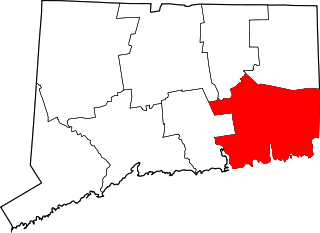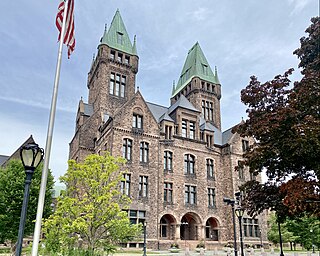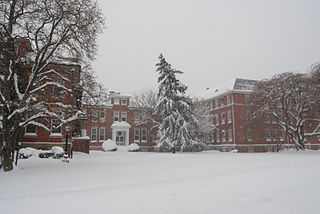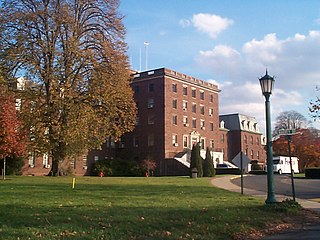
Montville is a town in New London County, Connecticut in the United States. The town is part of the Southeastern Connecticut Planning Region. The population was 18,387 at the 2020 census.

The Southeastern Connecticut region comprises, as the name suggests, the southeastern corner of the state of Connecticut. It is sometimes referred to as New London County or by the tourist slogan Mystic and More.

Mohegan Sun is an American casino, owned and operated by the Mohegan Tribe on 240 acres (97 ha) of their reservation, along the banks of the Thames River in Uncasville, Connecticut. It has 364,000 square feet of gambling space.

The Richardson Olmsted Campus in Buffalo, New York, United States, was designated a National Historic Landmark in 1986. The site was designed by the American architect Henry Hobson Richardson in concert with the famed landscape team of Frederick Law Olmsted and Calvert Vaux in the late 1800s, incorporating a system of treatment for people with mental illness developed by Dr. Thomas Story Kirkbride known as the Kirkbride Plan. Over the years, as mental health treatment changed and resources were diverted, the buildings and grounds began a slow deterioration. By 1974, the last patients were removed from the historic wards. On June 24th, 1986, the former Buffalo State Asylum for the Insane was added to the National Historic Landmark registry. In 2006, the Richardson Center Corporation was formed to restore the buildings.

The Crownsville Hospital Center was a psychiatric hospital located in Crownsville, Maryland. It was in operation from 1911 until 2004.

Hartford Hospital is an 938-bed acute care teaching hospital located in the South End of Hartford, Connecticut. Hartford Hospital was established in 1854. The hospital campus is located on Seymour Street in Hartford and is directly adjacent to the main campus of the Connecticut Children's Medical Center. Hartford Hospital was ranked #2 in Connecticut by U.S. News Best Hospitals and ranked #1 in the Hartford, Connecticut metro region by the same source. The hospital is a major tertiary care facility for the statewide region and is state designated as a Level I Trauma Center, able to care for the most critically injured of patients. It has 45 operating rooms and one of the largest surgical caseloads in the United States. The emergency room receives over 100,000 visits per year.
The Institute of Living is a comprehensive psychiatric facility in Hartford, Connecticut, that offers care across the spectrum of psychiatric services, including crisis evaluation, inpatient psychiatric care, group homes, specialized educational programs, outpatient programs, and addiction recovery services.

Connecticut Valley Hospital in Middletown, Connecticut, is a public hospital operated by the state of Connecticut to treat people with mental illness. It was historically known as Connecticut General Hospital for the Insane. It is a 100-acre (40 ha) historic district that was listed on the National Register of Historic Places in 1985.

Central State Hospital, formerly referred to as the Central Indiana Hospital for the Insane, was a psychiatric treatment hospital in Indianapolis, Indiana. The hospital was established in 1848 to treat patients from anywhere in the state, but by 1905, with the establishment of psychiatric hospitals in other parts of Indiana, Central State served only the counties in the middle of the state. In 1950, it had 2,500 patients. Allegations of abuse, funding shortfalls, and the move to less institutional methods of treatment led to its closure in 1994. Since then efforts have been made to redevelop the site for various uses.
The Association of Medical Superintendents of American Institutions for the Insane, also known as The Superintendents' Association, was organized in Philadelphia in October, 1844 at a meeting of 13 superintendents, making it the first professional medical specialty organization in the U.S.

The Hudson River State Hospital is a former New York state psychiatric hospital which operated from 1873 until its closure in the early 2000s. The campus is notable for its main building, known as a "Kirkbride," which has been designated a National Historic Landmark due to its exemplary High Victorian Gothic architecture, the first use of that style for an American institutional building. It is located on US 9 on the Poughkeepsie-Hyde Park town line.

Ralph Weston Sturges was an American Mohegan tribal chief who helped gain federal recognition for the Mohegan people of Connecticut in 1994. He also helped to found and build Connecticut's Mohegan Sun Casino. He held the title of "chief for life."

Broughton Hospital is a psychiatric hospital located in Morganton, North Carolina. It is administered by North Carolina Department of Health and Human Services Division of Mental Health, Developmental Disabilities and Substance Abuse Services.

Norristown State Hospital, originally known as the State Lunatic Hospital at Norristown, is an active state-funded psychiatric hospital located outside the city of Philadelphia in suburban Norristown, Pennsylvania. It was originally designed between 1878 and 1880, by the local firm of Wilson Brothers & Company; of which, the original structure was set in a red brick Victorian High Gothic motif. It remains active for its originally clinical intention, and currently serving Bucks County, Chester County, Delaware County, Montgomery County and Philadelphia County, providing clinical services in General Psychiatry and Forensic Psychiatry. Additionally, there are various agencies that sublet state hospital buildings for a variety of psychiatric, residential and social services. These agencies currently make up the majority of services that are offered on the grounds of the hospital.

Joshua's Tract Conservation and Historic Trust, or Joshua's Trust, is a non-profit 501(c)(3) land trust operating in northeast Connecticut. Joshua's Trust was incorporated in 1966 to help conserve property of significant natural or historic interest. As of 2011, the Trust protects more than 5,000 acres, maintains 42 miles of trails that are open to the public, holds educational outreach programs, and publishes the Joshua's Tract Walkbook.
Undercliff State Hospital was a roughly 40-acre (16 ha) hospital situated on Undercliff Road, Meriden, Connecticut. It operated from 1910 to 1976. The hospital was first built under the name Meriden Sanatorium to serve children with tuberculosis, German measles, chickenpox, and smallpox, but began to accept adult patients in 1939. In the early 1920s, the site name was changed to Undercliff Sanatorium. In 1967, it was changed once again to Undercliff Mental Health Center.
Elmcrest Hospital, later St. Francis Care Behavioral Health, was a small psychiatric facility in Portland, Connecticut. Opened in 1942, the campus incorporated three historic mansions, including a childhood home of 1800s businesswoman Elizabeth Jarvis Colt.

Cudworth & Woodworth, later Cudworth, Woodworth & Thompson and Cudworth & Thompson, was an architectural firm from Norwich, Connecticut.

The Maine Insane Hospital, later the Augusta Mental Health Institute (AMHI), was a psychiatric hospital in Augusta, Maine. It was the principal facility for the care and treatment of Maine's mentally ill from 1840 to 2004, and its surviving buildings represent the oldest surviving complex of mental care facilities in the United States. The complex is located on the east bank of the Kennebec River, immediately south of the former Kennebec Arsenal, and now primarily houses state offices. In 2004, the hospital was replaced by the Riverview Psychiatric Center, located just to the south. The hospital's core complex was listed on the National Register of Historic Places in 1982, with the listing enlarged to encompass the entire campus in 2001.
Legal forms of gambling in the U.S. state of Connecticut include two Indian casinos, parimutuel wagering, charitable gaming, the Connecticut Lottery, and sports betting.

















